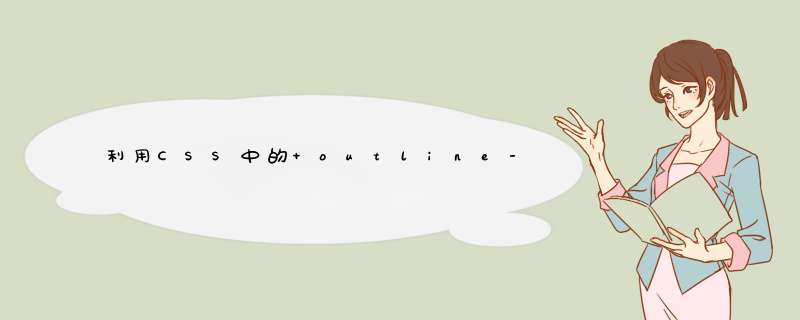
假设有这么一个初始代码:
<!DOCTYPE html>
<html lang="en">
<head>
<meta charset="UTF-8">
<meta name="viewport" content="width=device-width, initial-scale=1.0">
<title>Document</title>
<style>
div {
margin-left: 100px;
margin-top: 100px;
padding: 0;
width: 200px;
height: 200px;
background-color: green;
outline: 20px solid #000;
outline-offset: 10px;
}
</style>
</head>
<body>
<div></div>
</body>
</html>
其效果如下:
然后再把这个outline-offset属性的值改为-118px,那么就会把边框变成一个加号 当然我这里为了效果显著一些,我加了一个动画效果来显示,如下代码:
<!DOCTYPE html>
<html lang="en">
<head>
<meta charset="UTF-8">
<meta name="viewport" content="width=device-width, initial-scale=1.0">
<title>Document</title>
<style>
div {
margin-left: 100px;
margin-top: 100px;
padding: 0;
width: 200px;
height: 200px;
background-color: green;
outline: 20px solid #000;
animation: move 3s infinite;
}
@keyframes move {
0% {
outline-offset: 10px;
}
100% {
outline-offset: -118px;
}
}
</style>
</head>
<body>
<div></div>
</body>
</html>
其效果如下:
使用outline-offset做加号的总结
我觉得这个很有意思,在这里我试了很多次,在这里我总结了一下使用outline-offset属性负值的条件:
- 容器必须是个正方形
- outline 边框本身的宽度不能太小
- outline-offset 负值 x 的取值范围为: -(容器宽度的一半 + outline宽度的一半) < x < -(容器宽度的一半 + outline宽度)
在这个例子后,我又在想,CSS 属性可以取负值的属性和地方有很多,也有许多意想不到的效果。
大家最为熟知的就是负margin,使用负的 marign,可以用来实现类似多列等高布局、垂直居中等等。
那还有没有其他一些有意思的负值使用技巧呢?
下文就再介绍一些 CSS 负值有意思的使用场景。
使用 scale(-1) 实现翻转
通常,我们要实现一个元素的 180° 翻转,我们会使用 transform: rotate(180deg) ,这里有个小技巧,使用 transform: scale(-1) 可以达到同样的效果。
看个 Demo:
<!DOCTYPE html>
<html lang="en">
<head>
<meta charset="UTF-8">
<meta name="viewport" content="width=device-width, initial-scale=1.0">
<title>Document</title>
<style>
.g_container {
position: absolute;
margin: 100px 0 0 500px;
}
.item {
width: 100px;
height: 100px;
background-color: green;
position: relative;
border-radius: 50%;
}
.item {
transform: rotate(0) translate(-80px, 0) ;
}
.item:nth-child(1) {
animation: rotate 3s infinite linear;
}
.item:nth-child(2) {
animation: rotate 3s infinite 1s linear;
}
.item:nth-child(3) {
animation: rotate 3s infinite 2s linear;
}
@keyframes rotate {
100% {
transform: rotate(360deg) translate(-80px, 0) ;
}
}
</style>
</head>
<body>
<div class="g_container">
<div class="item"></div>
<div class="item"></div>
<div class="item"></div>
</div>
</body>
</html>
看看效果:
当然,如果想要让三个球同时运动,去掉这个延迟,那么可以改成这样的代码:
.item:nth-child(1) {
animation: rotate 3s infinite linear;
}
.item:nth-child(2) {
animation: rotate 3s infinite -1s linear;
}
.item:nth-child(3) {
animation: rotate 3s infinite -2s linear;
}
其效果我就不说了,就是同时运动,可参照上面的那个效果
负值 margin
负值 margin 在 CSS 中算是运用的比较多的,元素的外边距可以设置为负值。
在 flexbox 布局规范还没流行之前,实现多行等高布局还是需要下一番功夫的。
其中一种方法便是使用正 padding 负 margin 相消的方法。
有如下一个布局:
左右两栏的内容都是不确定的,也就是高度未知。
但是希望无论左侧内容较多还是右侧内容较多,两栏的高度始终保持一致。
OK,其中一种 Hack 办法便是使用一个很大的正 padding 和相同的负 margin 相消的方法填充左右两栏:
.left {
...
padding-bottom: 9999px;
margin-bottom: -9999px;
}
.right {
...
padding-bottom: 9999px;
margin-bottom: -9999px;
}
可以做到无论左右两栏高度如何变化,高度较低的那一栏都会随着另外一栏变化。
总结一下
除了这些,还有很多的属性,例子没有列出来(因作者的水平和时间有限),例如:
- 使用负 marign 实现元素的水平垂直居中
- 使用负 marign隐藏列表 li 首尾多余的边框
- 使用负 text-indent 实现文字的隐藏
- 使用负的 z-index 参与层叠上下文排序
总结
到此这篇关于利用CSS中的 outline-offset 属性实现加号的文章就介绍到这了,更多相关css outline-offset 属性内容请搜索脚本之家以前的文章或继续浏览下面的相关文章,希望大家以后多多支持脚本之家!
欢迎分享,转载请注明来源:内存溢出

 微信扫一扫
微信扫一扫
 支付宝扫一扫
支付宝扫一扫
评论列表(0条)